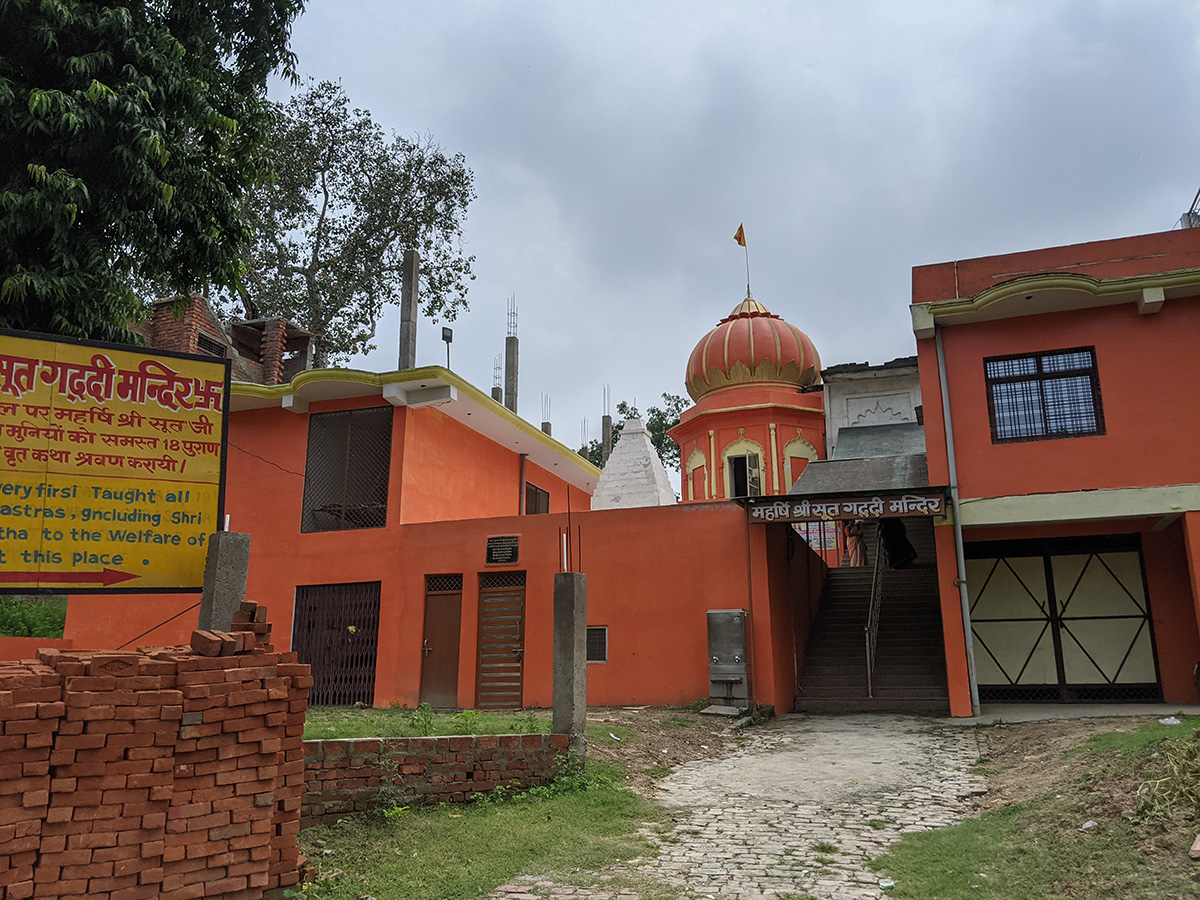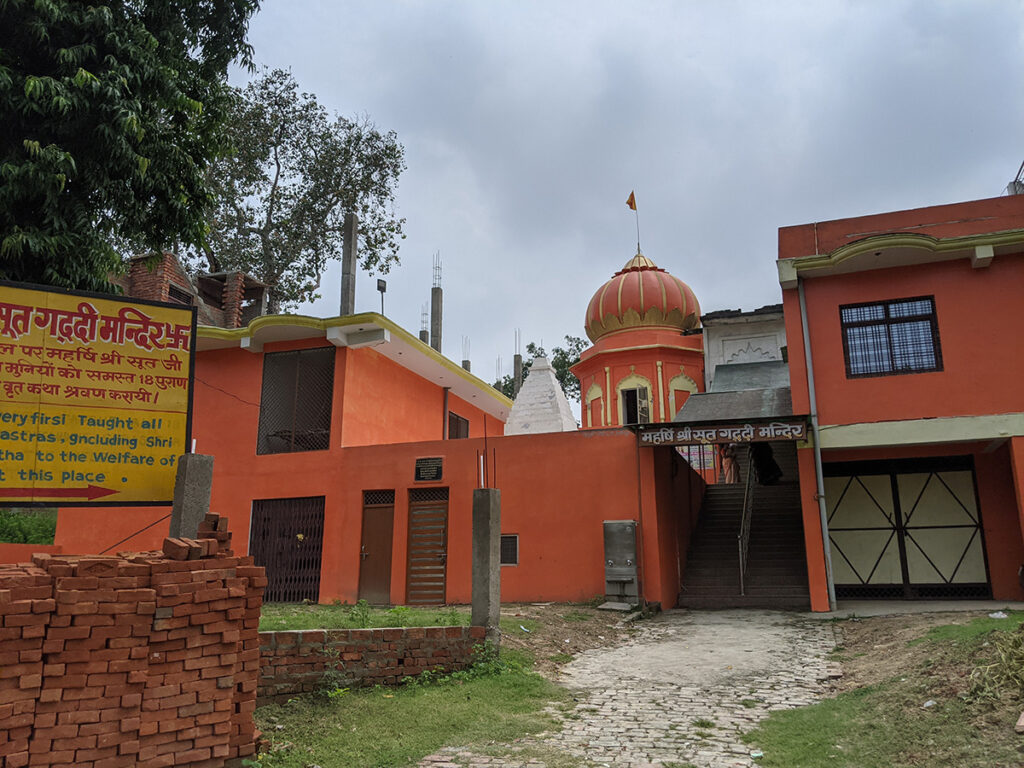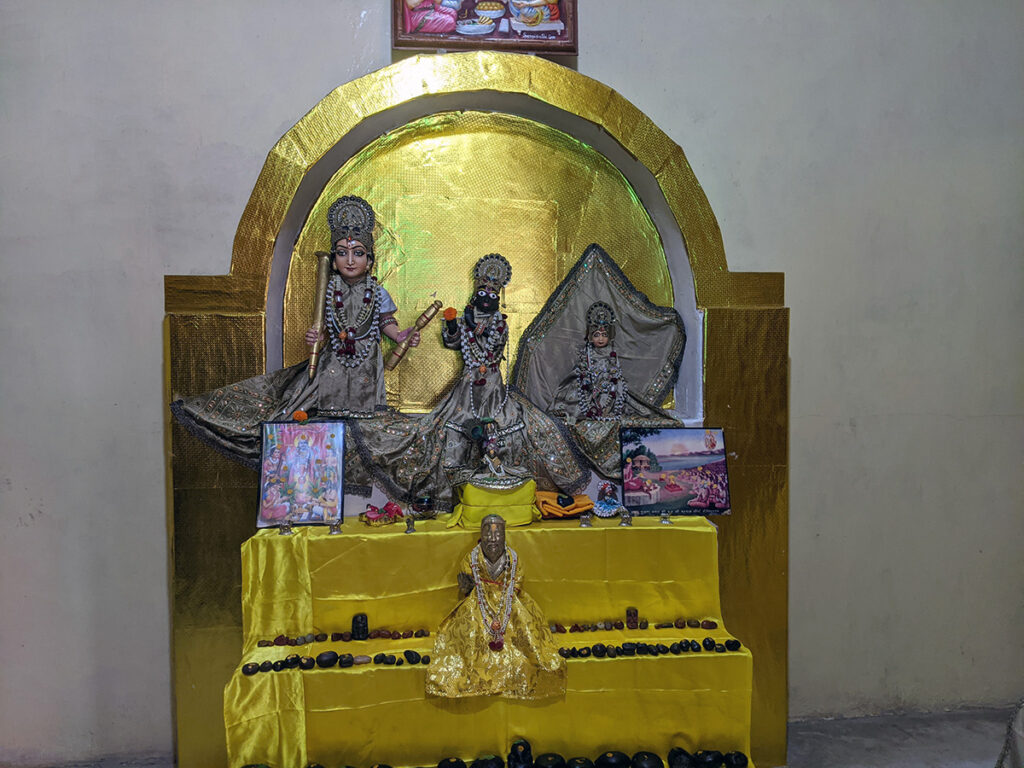
Suta Gaddi is one of the most sacred places not just on earth but in the whole universe. Naimisharanya is glorified as one of the eight self-manifested kshetras and one of the 108 Divya Deshams. Suta Gaddi plays a huge role in its glory! It is situated amidst the scenic views of nature and would benefit immensely from the renovation programs ordered by the Uttar Pradesh Government recently. This would greatly enhance its spiritual aura.
Srila Suta Goswami sat here and narrated the entire Bhagavata Purana comprising 18,000 shlokas to a big group of sages headed by Shaunaka Rishi. The Bhagavata Purana is witness to this event through the following shlokas:
naimiṣe ’nimiṣa-kṣetre ṛṣayaḥ śaunakādayaḥ
satraṁ svargāya lokāya sahasra-samam āsata
Once, in a holy place in the forest of Naimisharanya, great sages headed by the sage Shaunaka assembled to perform a great thousand-year sacrifice for the satisfaction of the Lord and His devotees. (SB 1.1.4)
The next shloka says:
ta ekadā tu munayaḥ prātar huta-hutāgnayaḥ
sat-kṛtaṁ sūtam āsīnaṁ papracchur idam ādarāt
One day, after finishing their morning duties by burning a sacrificial fire and offering a seat of esteem to Srila Suta Gosvami, the great sages made inquiries, with great respect, about the following matters. (SB 1.1.5)
The shlokas above show the eagerness with which sages headed by Shaunaka Rishi assembled here to eagerly hear from Srila Suta Goswami so that the entire world could be benefitted.
Vedic History of Suta Gaddi
Suta Gaddi is a very sacred place where Srila Suta Goswami narrated the entire Bhagavata Purana before a huge assembly of sages headed by Shaunaka Rishi. He heard the great devotee Srila Shukadeva Goswami narrating it to Parikshit Maharaj who had just seven days to live. Srila Shukadeva Goswami was the first personality to narrate the Bhagavata Purana while Srila Suta Goswami was the second.
Srila Suta Goswami recited the 18 Puranas, Upanishads and other important devotional literature along with the Bhagavata Purana. This very event, which was meant to benefit mankind happened here. He spoke the lila of the famous Satyanarayana Vrata here for the very first time. Not just these, he spoke about the Ekadashi Vrata, Ganesha Chaturthi Vrata and many other vratas here.
Lord Balarama killed Romaharshana Suta
Before the beginning of the Kurukshetra war Lord Balarama did not want to be involved in the warfare. Hence, he left for a pilgrimage. During His course of travels, He visited Naimisharanya and approached the assembly of sages where the narration of the Vedic Literation such as Puranas and Upanishads was going on.
As soon as Lord Balarama entered the assembly all the great sages stood up to bow to Him as mark of the respect except the Romaharshana Suta who was still seated on the Vyasasana. This angered Lord Balarama who then decided to kill the Suta. Lord Balarama killed him using a blade of grass.
Although Romaharshana Suta was puffed up by being seated on the Vyasasana, Lord Balarama’s action of killing him was not liked by the assembled sages of Naimisharanya. They prayed to the Lord to atone for the sin of killing a brahmana to set up an example for the common people.
Lord Balarama who is none other than the Supreme Personality of Godhead and master of His own will agreed to the proposal of the sages and asked them if he could regrant the life to Romaharshana. The sages of Naimisharanya did not want to revert the decision of Lord Balarama and asked Him to propose a solution by Himself.
Lord Balarama then posted Ugrashrava Suta, the son of Romaharshana Suta to the status of Vyasasana and granted him a longer life. The Sages had previously blessed Romaharshana to have a longer life until the end of the sacrifice. Ugrashrava then narrated the Bhagavatam. Lord Balarama asked the sages to request for a boon.
At that time there was a demon named Balvala, the son of Ilvala who used to disturb the sacrifices of the sages. All the sages unanimously asked the Lord to kill the demon and then take up a pilgrimage to the holy places for one complete year.
Lord Balarama killed the demon using His plough and then received a ceremonial bathing by the sages. He then began His yearlong pilgrimage to set up an example for the common man of how to atone the sin of killing a brahmana.
The Temple of Suta Gaddi
A medium-sized temple dedicated to Srila Suta Goswami has been built at this sacred site. It is called ‘Suta Gaddi Mandir’. Within the temple are the deities of Sri Sri Radha Krishna and Sri Balarama, 108 Shalagramas and a deity of Srila Suta Goswami himself. A Shivalinga as well as a small deity of Durga Devi can be observed in the temple premises. The remains of ancient Suta Gaddi temple can still be found today in this temple.
You can offer sevas for the upkeep of the temple such as deity seva, gau-raksha seva, Satyanarayana puja seva and many more sevas. Plans are afoot to construct a large Satyanarayana temple for the benefit of devotees along with other activities that would promote the principles of Sanatana Dharma.
Holy Places Nearby Suta Gaddi
Suta Gaddi is surrounded by many landmark holy places such as the Chakra Tirtha, Dadichi Kunda, Lalitha Devi Temple, Vyasa Gaddi, Gomti River and Hanuman Garhi. Around the Chakra Tirtha are a few temples and ponds such as the Bhuteshwar Nath Temple, Chakra Narayana Temple, Badri Narayana Temple, etc.
Best Time to Visit Suta Gaddi
If you are conscious about the climatic conditions, the winter season that falls between October and March is the best time. Else, devotees visit round the year and you too could.
How to Reach Suta Gaddi
Visiting Suta Gaddi, one of the sacred landmarks of Vedic History requires thorough understanding of the holy place. Devotees have experienced this on the Ayodhya Kashi Yatra conducted by Tirtha Yatra always along with the best amenities.
If you are in Naimisharanya Town, visiting this sacred landmark is quite easy. In the future, you could see yourself travelling to-fro Naimisharanya in electric buses or helicopters from Lucknow as part of the government plan to enhance spiritual tourism. These quick tips may help you reach without hassles –
By Road: Naimisharanya is well connected by roads including local, state highways and national highways to major cities across India. Both state and private bus services operate on this route. Lucknow, the capital of Uttar Pradesh is around 90 km from Naimisharanya.
You can choose to drive up all the way to Naimisharanya or hire a taxi too.
By Rail: Sitapur Junction (STP) 39 km away connects Naimisharanya to other stations across India. If you plan accordingly, you can alight here and use the road route to Naimisharanya. But Lucknow Railway Station (LKO) is the nearest major station with trains from all regions of India.
By Air: Chaudhary Charan Singh International Airport in Lucknow is the nearest airport to Naimisharanya. It serves a few domestic and international destinations (middle-east). The Indira Gandhi International Airport in New Delhi is the nearest airport which serves pan-Indian and pan-Global destinations. You can fly in to these airports and use the road or rail route.
Suta Gaddi: The High Seat of Knowledge
Srila Suta Goswami is one of the greatest authorities in Vedic knowledge. He heard and memorized the Bhagavata Purana which was being narrated by Srila Shukadeva Goswami, another leading authority on Vedic knowledge. This was indeed the arrangement of Kala i.e. time so that the masses of Kali Yuga including ourselves would benefit and attain liberation.
Vyasa Peeta is the highest seat of learning and Suta Gaddi represents it. The highest secrets and ultimate goal of the Vedas were revealed here. It is indeed highly worthy of worship!
As you enter with devotion, the transcendental presence of Srila Suta Goswami can be felt here. If you sincerely desire to know the highest secrets of the Vedas, his blessings can be sought with a sincere prayer in devotion.
0












Leave a Reply